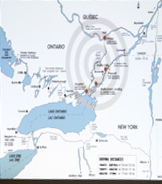Presentation by Gavin Liddy, Superintendent of the Rideau Canal, Parks Canada to the Rideau Branch, Ottawa Archives, North Gower; October 17, 2007
This year (2007) marked the 175th anniversary of the opening of the Rideau Canal, North America's oldest continuously operating waterway, a National Historic Site of Canada and a UNESCO World Heritage Site.
Mr. Liddy provided an overview of the history and current use of the Rideau Canal as well as the honour of the UNESCO designation.
The Rideau Canal was originally built to provide an alternate route to the St Lawrence River from Montreal to Lake Ontario for military purposes. However it soon became an important facility for the settlement of the lands between Ottawa and Kingston.

Map showing the Rideau Canal, Ottawa to Kingston
From the 1830's to the 1930's steamboats plied these waters carrying supplies to the farms and villages on one hand. On the other they carried farm produce, lumber, cheese and various other cargo the big cities, and for export to the US and Europe.
These steamboats also carried passengers. The passengers traveled on business, for visiting friends and family and for pleasure and sightseeing. So even in the early days the Canal supported a small and growing tourist business.
Tourism, fishing, and pleasure boating, of course, is the main business of the Rideau Canal today.
The designation of the Canal as a UNESCO World Heritage Site was a signal achievement.
UNESCO is the United Nations Educational, Scientific, and Cultural Organization. The establishment of "World Heritage Sites" falls under the cultural responsibilities of UNESCO.
Among the goals of the UNESCO's World Heritage mission are the two following responsibilities:
to encourage countries to sign the World Heritage Convention and to ensure the protection of their natural and cultural heritage; and
to encourage States party to the Convention to nominate sites within their national territory for inclusion on the World Heritage List.

Betty Bartlett presenting gift ot Mark Brus
Canada is a signatory of that convention. Parks Canada recognized that the Rideau Canal was an excellent candidate for World Heritage Site status and worked with UNESCO to submit the application and meet all their requirements for supporting information.
It is not an easy task to achieve the World Heritage designation. The decisions are only made after exhaustive studies of the site to ensure it meets all the rather complex conditions. These studies for the canal application included site visits whereby officials of UNESCO toured the canal from Kingston to Ottawa and carefully inspected every lock station.
Of course virtually nothing in human experience ever turns out to be absolutely perfect. In our case one or two of the locks had been automated and mechanized to avoid the manual labour of opening and closing. UNESCO chose to overlook this deviation.
When two organizations such as UNESCO and Parks Canada are involved in a multi year beneficial endeavour such as this, friends are made and trusts are established so that behind the scenes information comes available. Thus the Canadian delegation was able to discover that their proposal was one of the best prepared ever submitted for World Heritage designation. Congratulations to Parks Canada.
Mark's presentation was very much enjoyed and everyone left with a good understanding of the process for designation as a World Heritage Site.
